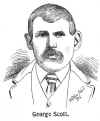peace for Rock Branch township in 1878. Mr. Dopps has been a republican ever since the party was organized until lately, but for the last few years has voted the prohibition ticket.
 George Scott was born at Apledoorn, Holland, October 30, 1844; came to America in 1867; settled at Fon Du Lac, Wisconsin.
Was married July 37(??), 1868, to Miss Lydia Berning. She was born at Weith, Germany, September 12, 1847; came to America in 1866.
They came to Kansas in 1870; settled at Tonganoxie in Leavenworth county; moved to Phillips county in 1872; came to Norton in March 1873 and took land three miles north of Norton where he has resided continuously ever since.
They have five children: their eldest daughter Hattie was born October 22, 1870.
She married Samuel Rowley in 1891 and moved to Rawlins county where they now reside; Emma, their second daughter was born
March 5, 1874; Dick born February 27, 1879; Lizzie November 17, 1882 and Mary September 3,
1886??.
George Scott was born at Apledoorn, Holland, October 30, 1844; came to America in 1867; settled at Fon Du Lac, Wisconsin.
Was married July 37(??), 1868, to Miss Lydia Berning. She was born at Weith, Germany, September 12, 1847; came to America in 1866.
They came to Kansas in 1870; settled at Tonganoxie in Leavenworth county; moved to Phillips county in 1872; came to Norton in March 1873 and took land three miles north of Norton where he has resided continuously ever since.
They have five children: their eldest daughter Hattie was born October 22, 1870.
She married Samuel Rowley in 1891 and moved to Rawlins county where they now reside; Emma, their second daughter was born
March 5, 1874; Dick born February 27, 1879; Lizzie November 17, 1882 and Mary September 3,
1886??.
Henry Chapman came into Norton county on foot early in March 1873. He was a native of Ohio but had left that state for the gold fields of California in 1849, and from that time until he came here had spent his life on the frontier.
He took a claim two miles west of Norton, the same land is now known as the Nathan Gray farm.
He was reported to be worth considerable money although no one here so far as known, ever had the pleasure of feasting his eyes on the fabulous bag of gold; yet he had often spoken to the settlers of being possessed of a considerable sum of that precious metal.
He built a log house on his claim but never put a roof on it. The eccentric characteristics of the man showed themselves plainly in regard to this as he had spent several days in walking up and down the creek looking for a tree with the proper crook in it to make rafters for his house; he wanted the rafters to reach from eve to eve with a curve over the ridge log or center pole.
At the same time he was looking along the creek for a good mill-site and had avowed his intention of building a mill that season.
Just before his death he had been down the creek looking for a good location for a mill and had decided on building a mill near the point where the Almena mill now stands.
On this trip his belt of gold, that he carried buckled around his body under his clothing had chafed him so that he had taken it off and buried it under the rocks on the stony point south of
Almena. The following night it rained and he feared the water might wash the dirt off from the money, and as it was a rawhide belt or sack he thought the wolves might scent it, so on the following morning he started back after it.
On his return that evening he stopped at Henry Oliver's dug out and told him all about it and said he found the gold all right and had it on his person at that time.
This is the last time he was ever seen alive by anyone who lives here now.
He had purchased a yoke of cattle after coming here, but always made his excursions up and down the creek in looking
|